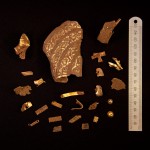 Eighty-one pieces of gold and silver discovered by archaeologists this past November in the same field where the Staffordshire Hoard was found in 2009 have officially been declared treasure. The South Staffordshire Coroner Andrew Haigh ruled that out of the 91 recently discovered pieces, 8 were modern “waste”, 2 were found far enough away that they should not be considered part of the original hoard. The remaining 81 he ruled to be 7th century Anglo-Saxon pieces buried along with the more than 3,900 pieces of the Staffordshire Hoard.
Eighty-one pieces of gold and silver discovered by archaeologists this past November in the same field where the Staffordshire Hoard was found in 2009 have officially been declared treasure. The South Staffordshire Coroner Andrew Haigh ruled that out of the 91 recently discovered pieces, 8 were modern “waste”, 2 were found far enough away that they should not be considered part of the original hoard. The remaining 81 he ruled to be 7th century Anglo-Saxon pieces buried along with the more than 3,900 pieces of the Staffordshire Hoard.
The next step is for the 81 pieces to be valued by a committee of experts at the British Museum. Once a market value is assessed, the county authorities and local museums will raise the money so they can purchase the recent discoveries and add them to the mother hoard. There are no estimates of value out as of yet, but it’s certain to be far lower than the £3.3 million ($5.5 million) the initial find cost. None of the 81 pieces are as large and elaborate. One potential cheek guard from a helmet is the largest piece and is particularly exciting because it could prove to be the match of one found the first time around.
Still, the Staffordshire County Council is excited about the new finds and is already planning to raise the funds.
Philip Atkins, leader of Staffordshire council, said it and the owners of the original hoard, Stoke-on-Trent and Birmingham councils, would now have to look at raising money to buy the new items.
“Last time we raised £1m in public donations in just 12 weeks. This time we won’t need nearly as much money, but I would encourage people to donate. It’s important for our region that the hoard stays together. Just as York is associated with the Vikings and Bath with the Romans, so too will Lichfield be connected to the Anglo-Saxons,” he said.
 The moneys raised will be split between Terry Herbert, the metal detectorist who made the original discovery, and Fred Johnson, the landowner. They will also receive the 10 pieces declared non-treasure, which might be tricky given that they fought over the money after the initial discovery and haven’t spoken since.
The moneys raised will be split between Terry Herbert, the metal detectorist who made the original discovery, and Fred Johnson, the landowner. They will also receive the 10 pieces declared non-treasure, which might be tricky given that they fought over the money after the initial discovery and haven’t spoken since.
The new pieces will then move to a permanent home in the Birmingham Museums and Art Gallery and the Potteries Museum & Art Gallery in Stoke-On-Trent. where the original hoard is on display. As challenging as it was for these small regional museums to raise the money, the hoard has turned out to be a financial boon to the region, drawing more than one million visitors since 2009. Loans of some of the artifacts to Washington, D.C., and a Discovery Channel documentary also brought in money.
WERES MY SHARE OF THE MONEY IV ACTULLY GOT THE RIGHT TO IT